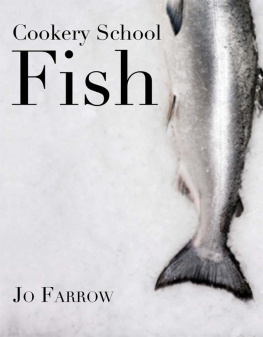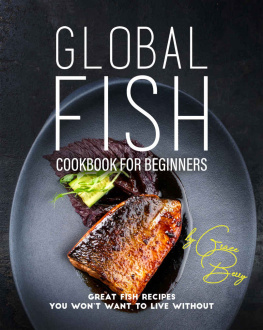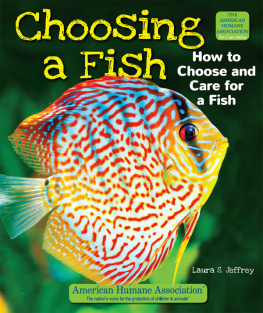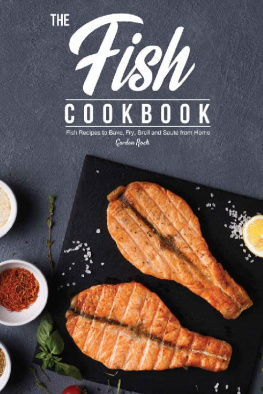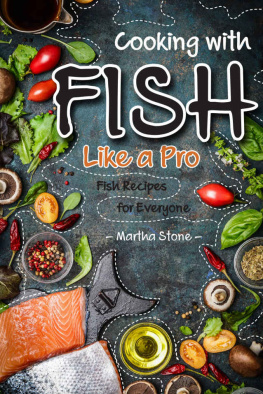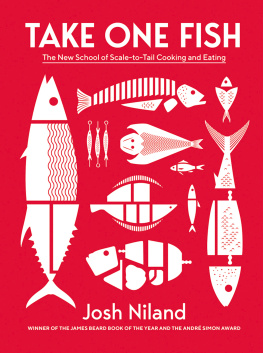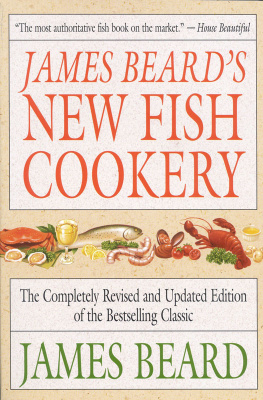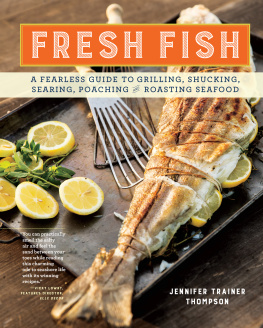Contents
Guide



Contents



Introduction

B eautifully fresh fish is often best served simply cooked. A whole grilled (broiled) plaice topped with a dot of butter and seasoning; a plump baked salmon fillet drizzled with a squeeze of lemon; or mackerel fried with crispy bacon all delicious dishes that tempt the palate with their sublime flavours and divine taste. These dishes are simplicity itself to cook, and may help demystify cooking with this ingredient. Most of us are more wary of cooking fish than meat, perhaps because were simply less familiar with it. Sure, fish does require more careful treatment than meat, as its so quick to cook through and may fall apart if overdone. Like other ingredients it will also dry out if cooked for too long, and then of course, there are the bones perhaps the reason why most people shy away from cooking and eating this versatile ingredient.
There are many different ways of cooking fish, and each chapter of this book provides easy-to-follow instructions for each method, as well as plenty of recipes to try with your newly honed skills. From grilling and barbecuing to roasting and poaching, simple recipes are provided to illustrate the process. So, even if youve never cooked fish before, youll see just how straightforward it is. Many of the recipes can be prepared and cooked in less than 30 minutes, which makes fish the ultimate fast food!

SUSTAINABLE FISHING
In recent years issues such as sustainable fishing and responsible buying have become very focal to the fishing industry and our shopping habits. Sustainable fishing and protecting the marine environment will help to ensure that we can enjoy a wide range of seafood, both now and into the future so its worth using our purchasing power as an influence.
The way in which some fish are caught can have an impact on other types of fish in the same waters so its important that you choose fish with the fishing method clearly labelled. This might be using hooks and lines, nets and pots, or even in the case of scallops and clams, harvesting by divers a good fishmonger will be able to advise you and supermarkets should label their products accordingly. Products should be avoided if they are fished by bottom trawling, a method of fishing in which a net the size of a ruby pitch is dragged along the bottom of the sea floor, churning up and destroying the environment as it goes, and capturing unwanted species. Pair netting, in which two boats run alongside each other with a net between the two, also causes bycatch, meaning species that are not wanted for sale are caught in the net, and are then thrown back overboard, but generally when they are dead. Bycatch includes all manner of sea creatures, as well as fish not included in the quota. Generally, there has been a lot of progress in this area but theres still much further to go. You can check out various marine conservation and sustainable fishing websites for information on responsible fishing and purchasing. Youll also find lists of fish that we should be eating less of due todepleted stocks, as well as those we should be making every effort to enjoy more of. There are also the fish in the middle, those that should be eaten occasionally maybe a treat to enjoy once in a while!
There are literally dozens of types of fish to try! We may be unfamiliar with many of these, or unsure what to do with them, but many are becoming more commonly available. Now is the time to experiment with the unfamiliar they just might become your everyday favourites.
If you can, choose locally caught fish in favour of those that might have been flown a long distance. This also makes us more aware of fish seasons as some types of fish, like other foods, have seasons and are only available at certain times of the year. Some types of fish, like other foods, have seasons and are only available at certain times of the year.
Farming fish
This rapidly expanding worldwide industry can offer a sustainable alternative to over-fished wild stocks as well as cope with the increasing demand for popular species. Many are now farmed including salmon, trout, tilapia, sea bass, halibut, turbot, cod, sea bream, tuna, mussels, clams, oysters and prawns. Fish farming has suffered bad press on various aspects of its production including its use of chemicals, wild feed, lack of space, pollution and taste. Ongoing research and new techniques are working to clean up fish farming to make it a worthy alternative to buying wild fish.

BUYING FISH
Fresh fish
Choosing quality fish is the first step to creating a beautifully cooked dish, so its worth being very selective. If youre lucky enough to have a good fishmonger near you, and the quality and source of the produce is guaranteed, then youre part way to producing a delicious dish. When buying fish it pays to be flexible about the type that you buy the fish you want might not be available on that particular day, or you might see another variety that looks more appealing. The fishmonger will be able to advise you on substituting one fish for another, as well as on fish flavours and textures, how much youll need to buy and cooking methods (for when you confidently deviate from the recipes in this book!). Most importantly the fishmonger should know where and how the fish has been caught. The fish shop, or counter, should not have a strong, stale fish smell, but subtle fresh sea salt aroma. Avoid any fish, or fish counters, with a strong ammonia smell.
Choose whole fish with bright, plump eyes, rather than sunken dried ones. They should have a glossy, fresh sheen and an air of slipperiness about them as though theyve only just been caught. The bodies should be plump and firm with bellies intact rather than split, which might be an indication of staleness, particularly on oily fish. Fillets should look moist and succulent with flesh that holds together firmly. Avoid dull, ragged, dry looking pieces. Oily fish like mackerel, sardines and herrings deteriorate quickly so be particularly careful when choosing these.
Frozen fish
Todays fishing vessels are fully equipped with freezers, meaning that many fresh fish caught at sea will be prepared for sale and frozen while still at sea, so its fished and frozen within a short time span.
White fish and shellfish are good products to buy frozen, but always make your purchase from a store with a fast turnover of stock. The flavour of fish will gradually deteriorate if it is frozen for more than six months. Fish such as salmon and trout will keep for up to three months in the freezer, but some oily fish should never be frozen.

